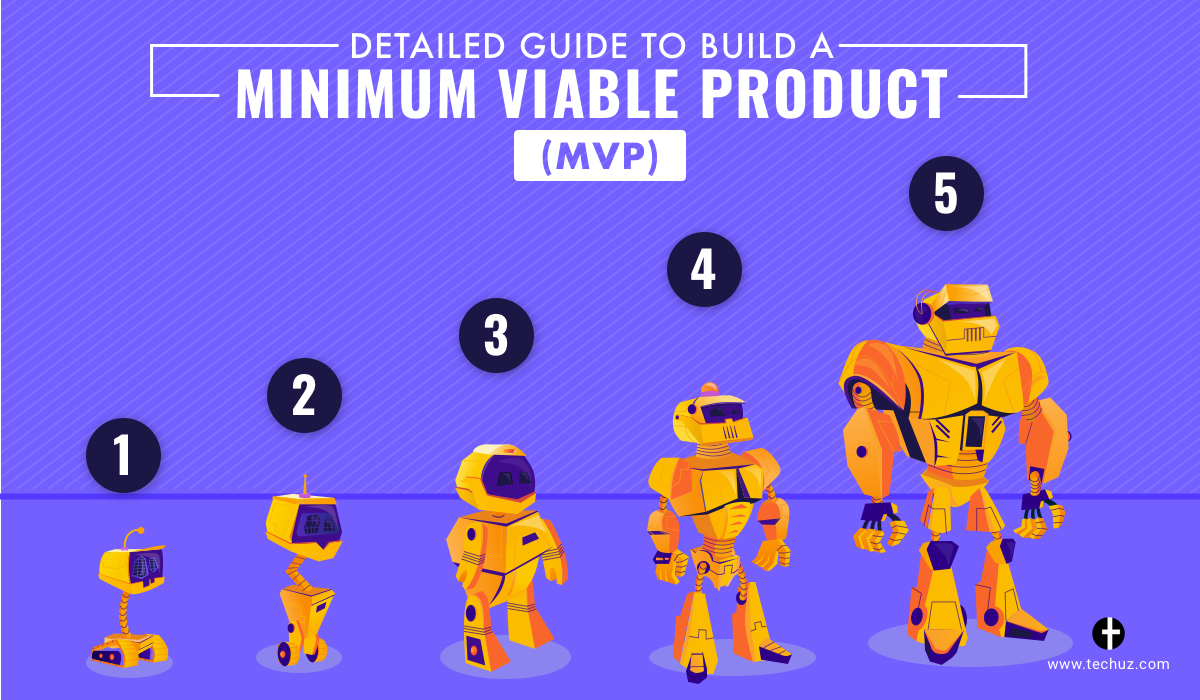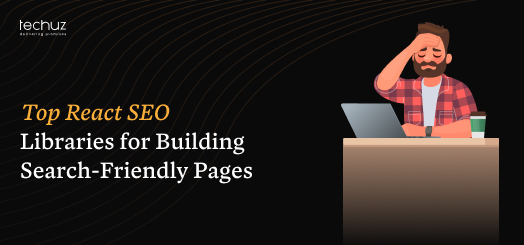Posted on
September 3, 2019
Updated on
March 20, 2024
Read time
 19 mins read
19 mins read
“Started from the bottom, now we’re here”. This line from Drake’s chartbuster is precisely relatable to a startup’s journey from an MVP to scaling up. As an entrepreneur looking to bring your idea to life, you have to start somewhere at the bottom. Built something small. With scarce resources. Something… minimal.
And with time, you gather feedback from the users, learn from the mistakes and improve your product and eventually grow your startup. From the bottom — an MVP to the top — a sophisticated product.
At Techuz, we have been working with entrepreneurs and startups to build their idea from scratch — starting from validating with an MVP to scaling it in a feature-rich application.
So we decided to write an article and share every detail you need to initiate your humble beginning or to say — develop a minimum viable product.
By the end of this article you’ll get an idea about:
- What is a Minimal Viable Product (and what’s not)
- Why your startup needs to build an MVP
- Benefits of MVP
- A step-by-step guide to build your MVP
Sounds like a plan? Alright, so let’s dive in.
What is a Minimum Viable Product?
Minimum Viable Product or MVP is a product with just the basic necessary features that are enough to satisfy the needs of the users and enable feedback gathering. The idea here is simple — develop a product to gauge the user’s reaction about the idea, learn from their feedback — and use it to develop a product that users love.
Here’s how Eric Ries the author of ‘The Lean Startup‘ defines MVP.
“The minimum viable product is that version of a new product which allows a team to collect the maximum amount of validated learning about customers with the least effort.”
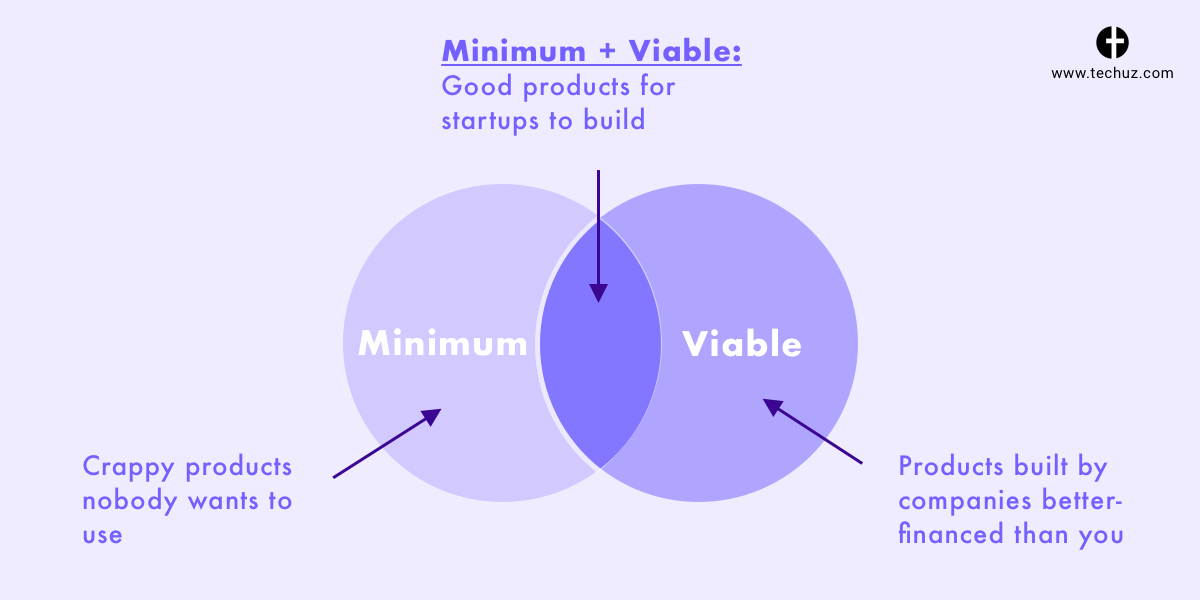
(Minimum features but viable enough to solve users’ problem — that’s MVP)
If we breakdown the term ‘minimum viable product’, we get a very clear explanation and basic three characteristics of MVP.
- Minimum – Just basic necessary features — just the crux, no-fluff.
- Viable – These basic features must fulfill the needs of the users.
- Product – A product, something that enables users to share their feedback for future development.
Is MVP the Same Thing as Prototype?
An MVP and a Prototype are two different concepts. In fact, as per the lean startup methodology, they are two different stages of the product. Here’s what the process looks like:
- Prototyping
- Minimum viable product (MVP)
- Product-market fit
- Scaling
So what’s the difference between a Prototype and MVP?
A prototype is a graphical representation of the product. It is clickable but serves no functionality and merely used to represent the idea. It can be used to display and convince the investors and users but can’t be launched in the market.
While MVP, on the other hand, is a functional and working product that can be used by the customers.

(Difference between prototype, MVP and final product)
Why Your Startup Needs an MVP?
A report by CB Insights revealed that 42% of the startups fail because there was no market need. They made products that no one wants.
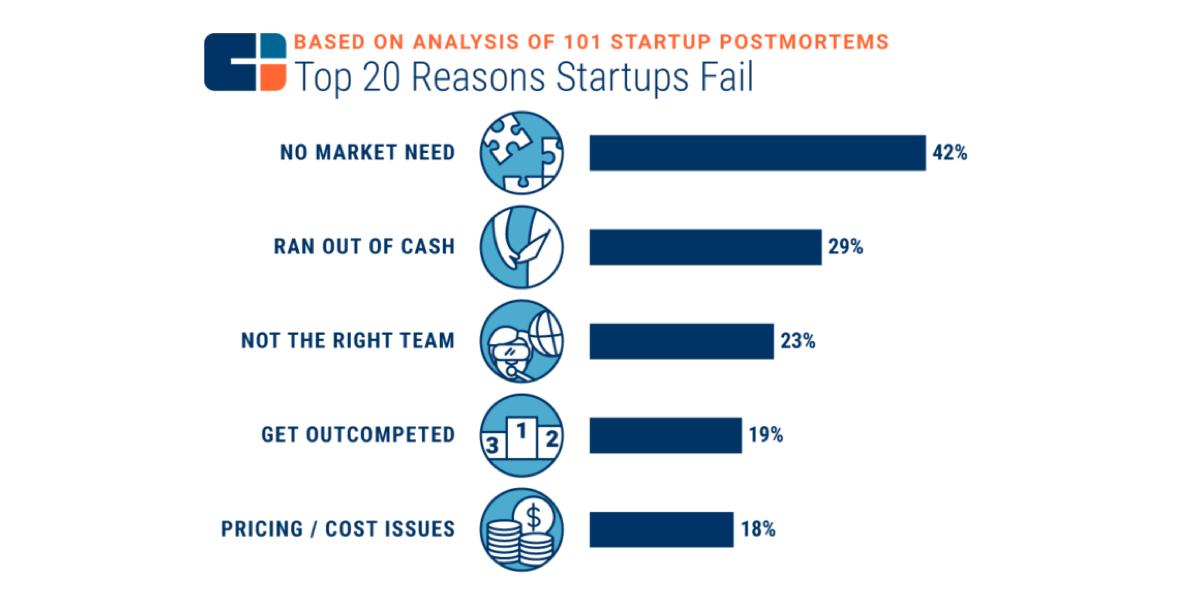
(Majority of startups failed because there was no market need for their product – Startup Postmortem Report by CB Insights)
This generally happens when the entrepreneurs are too ambitious about their idea. They create a product that is too idea-centric rather than keeping the customers at first place. They spend their time, money and resources on developing a fully-featured product without understanding the needs of the end-users. And that’s a total disaster.
This is where MVP comes in. It helps you validate your hypothesis at the very beginning so you don’t end up spending your time and fortune on a product that users don’t care about. Zappos is the epitome in this case.
Back in 1999, when buying clothes and apparel was not a household trend, founder Nick Swinmurn validated his idea of selling shoes online with an MVP.
Instead of spending thousands of dollars on creating a platform and buying inventory, he photographed the shoes from the local store, placed them on sale on his website and when the customer placed an order, he would purchase that shoes from that store and get it delivered. Although it was not a sustainable business model, he was able to validate his idea — there’s demand for buying online shoes.
Today, Zappos is one of the leading online clothing retail stores in the US selling over 50,000 clothing items and earning over $2 billion in revenue.
Benefits of Building an MVP
Build the Core of Your Product
A minimum viable product focuses on building the core of your product, the basic necessary features. This enables developing the main idea of your product first and the less necessary ones at a later stage.
Enables Market Validation
Developing your MVP and launching it in the market among the users enables the market validation. It helps you understand if your users will accept your product, what makes your product unique and gather feedback to make the product better.
Reduce Rework
There are very high chances of rework when building extended features of unreleased software. On the other hand, when you build just the necessary features to test your product and receive feedback for future development, there’s significantly less need for rework. Thus when you keep your initial product release minimal and subsequent releases incremental, your product will be more aligned with the market.
Release Faster
Building an MVP is the fastest way to bring your idea in the market. It’ll prevent the procrastination of the launch by developing a simple and functional application.
Further, you also start building a customer base at an early stage. Your initial release will be used by early adopters who are more likely to interact with your product and provide constructive feedback. Thus, you’ll get a roadmap for future development along with building relations with customers.
Validate Business Functions
An MVP not only validates the product idea but also helps you evaluate your other business functions such as sales, marketing and business model assumptions as well.
Steps to Build MVP
1. Conduct a Thorough Market Research
Before you develop an MVP to validate your hypothesis, you need to validate it through market research. You must look for the data about your audience and competitors that’ll help you build an effective MVP. There are different ways such as conducting surveys, using marketing tools and competitor analysis that you can use to gather market data. Let’s discuss them in detail.
Surveys
You can gather data about your potential customers through surveys or even face-to-face interviews. Ensure you are using a combination of both quantitative as well as qualitative methods. Quantitative methods focus on user behaviour — “what” your customers do while qualitative methods focus on the “why” the customer do — the reason behind their behaviour.
For example, you can survey customers on what products do they use for the “X” problem while at the same time gather information on what makes them use that specific product. Is it the price, design or usability? Gathering this information will help you to build an MVP that resonates with the needs of your target audience.
Competitor Research
Research about the competitors in the market, analyze their audience, their performance, their strengths, weaknesses and use this data while developing your own product. Competitor analysis will help you identify the opportunities for market penetration.
2. Define the User Flow
The next step is to define the user flow where you’ll decide how the users will interact with your application. A user flow or UX flow is a path that the user goes through to complete a task on the web or mobile application.
You need to create a flow for each individual screen where the user will interact with your application. Each screen shows something to the users and they interact with it. Defining the user flow ensures you don’t miss any step in the interaction funnel and even makes it easier for the designer and developers to understand. While creating the user flow, you need to consider these three things:
- The ‘happy path’ – the usual way to complete a task.
- What happens when the users don’t follow the ‘happy path’?
- Possible alternative paths to complete the task.
Using tools such as Flowmap, Marvel or Invision can be handy and help you to design the flow in a better way. Another simple alternative to defining user flow is using state diagrams. Here’s how a state diagram an online ticket booking MVP app would look like.
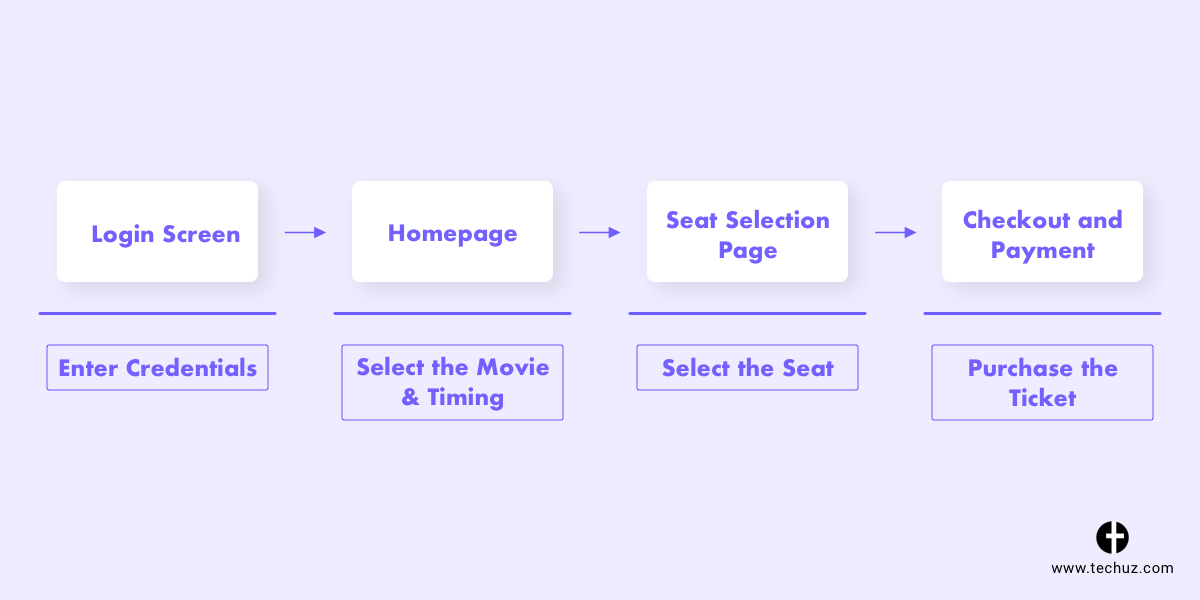
(An example of user flow using state diagram)
In the above example, there is an entry point, an exit point and other necessary steps to be taken to complete an objective. You can define the user flow in this way laying out the stages that the user has to take to achieve the goal.
3. Make a List of Necessary Features and Prioritize Them
So once you have the user flow ready, it’s time to make the list of features of your MVP. To start with, make a list of all the features that you want in your product. Once you have the list, it’s time to decide what features go inside the MVP.
Although selecting the features might sound easy, it is indeed a tricky part. The reason being your MVP must include the most basic features enough to validate the product idea at the same time prove the product-market fit.
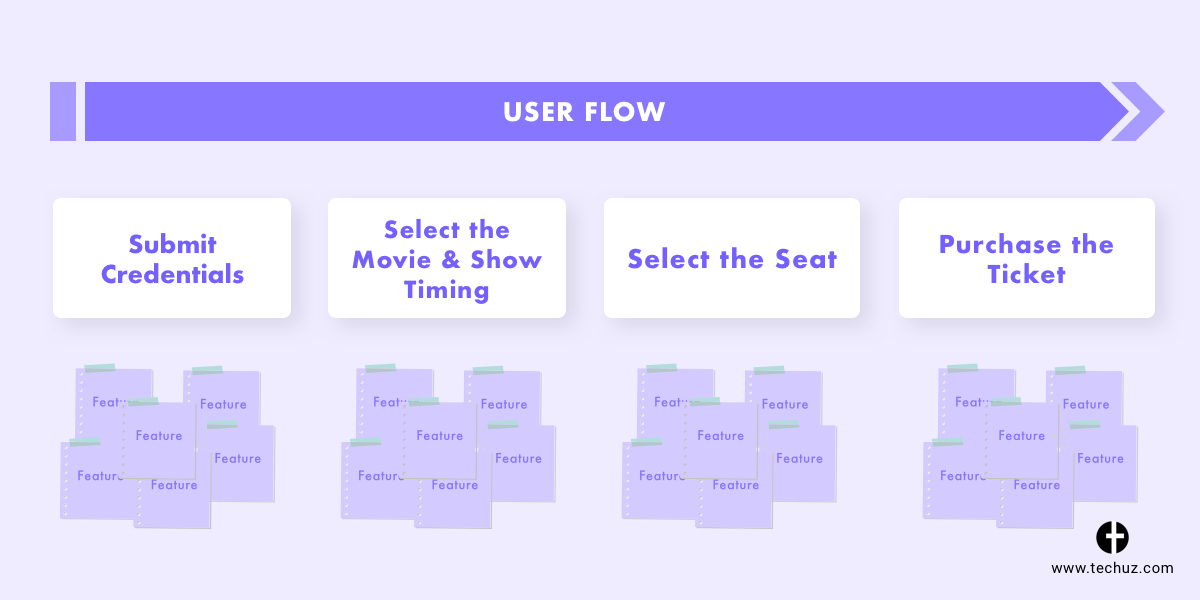
(List of all the features as per the user flow)
Here are a few tips that can help you prioritize and select the features for your MVP.
Add “Must Have”, Eliminate the “Nice to Have”
By this time you should have pinned down in your head that the MVP should only have the bare minimum features. This means, no bells and whistles, no-frills, no fluff and no “nice-to-have” kind of features. One of the handy methods to sort must-have and nice-to-have features is to use story mapping.
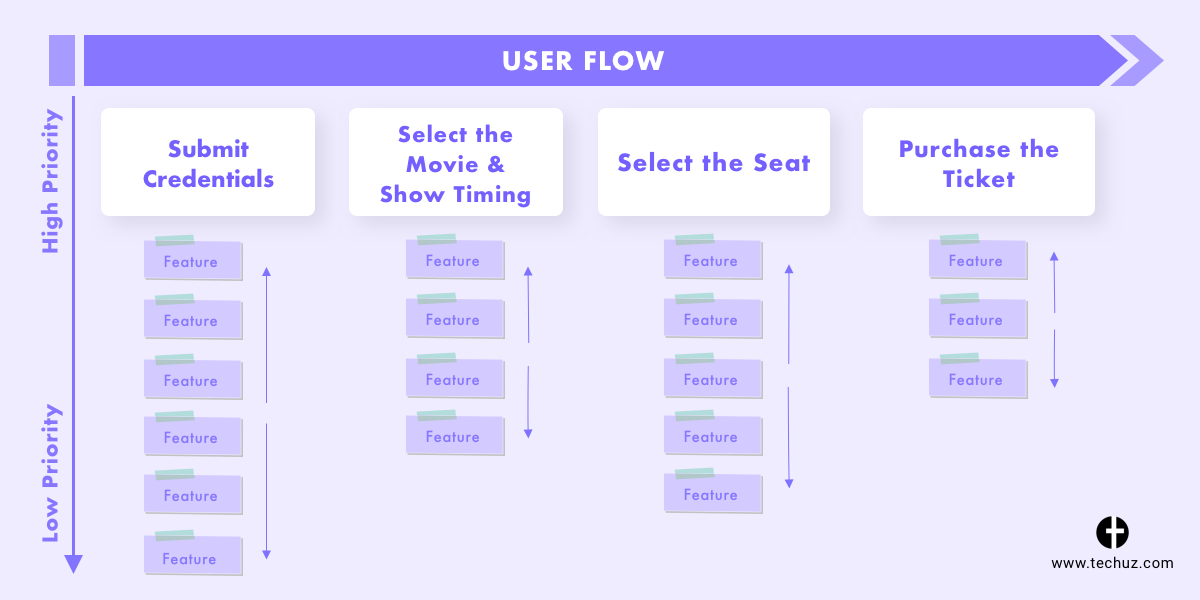
(The primary goal of this user flow is to allow users to book and purchase a movie ticket. Here’s how you can prioritize the features using story mapping)
Your MVP must deliver just the core value so you need to ask yourself: Is this feature critical to validate my idea or does adding/removing this feature affects the function of the app? Eliminating the “nice-to-features” and adding only “must-haves” aligned exactly with the core value will dramatically reduce the time to market and even the cost incurred in development.
Focus on Serving a Specific Audience Segment
Initially, your product should target only one specific segment of the audience. The idea of serving multiple customer segments should be kept for the later stages.
When developing an application, your audience can be divided into 5 types, viz. innovators, early adopters, early majority, late majority and laggards. Your target segment for MVP should be the innovators and early adopters. These two segments are more expected to provide feedback for validating the idea and future development.
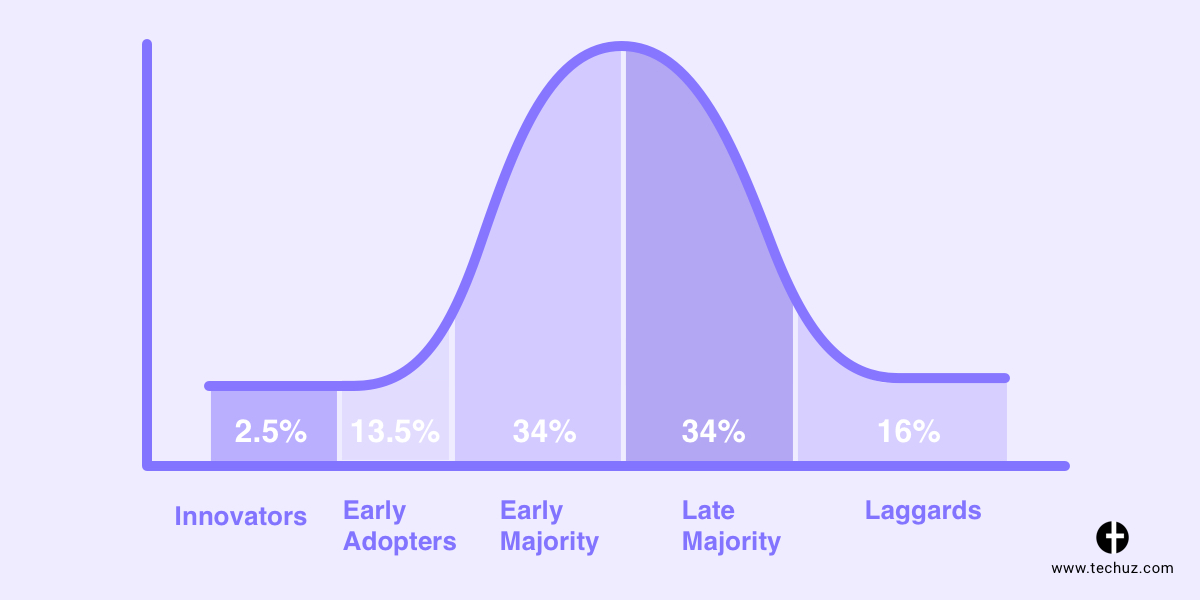
(Innovators and Early Adopters – Targeted audience segments for MVP)
Thus, keep in mind that your MVP is not made to serve everyone but a specific segment and you must select the features based on that.
Prioritize the Features Based on the KPI
Another method you can use to prioritize the features is based on the KPIs and KPI factors. Let’s see how it works.
- Make three columns, viz. Features, KPI and KPI factor on a whiteboard or spreadsheet.
- Write down all the features in the first column along with the respective KPIs in the second one.
- Now add the value based on a scale of 1 to 10 in front of each KPI (10 being highly necessary and 1 being the least one).
- Once you have given value to all the features and KPIs, you can sort it in the descending providing you with the most valuable features.
Here’s an example of explaining the same.
Let’s say your MVP is a movie ticket booking platform. For the MVP we can add features such as “User Signup” with KPI “Number of signups”.
It is the basic feature of the platform where the user needs to sign up to book the movie ticket. This feature is a must-have so we can rate the feature a 10 on the scale.
Another feature can be “rewards points” and it’s KPI is “user retention”. Though this is a nice feature, it’s not a must-have. When comparing to other necessary features we can rate it 6. This means if there are higher ratings for other features, this won’t go into the MVP.
The selection of features based on KPIs and ratings helps you to get a better idea of the necessary features. Providing them a number value give you a more specific idea and KPIs make sure you are selecting the right features aligned with your business.
4. Built the MVP
You have conducted market research, defined the user flow, prioritize the features and now it’s the time to build the MVP. The MVP build process includes designing the product, the development and varying stages of testing before it reaches the users. While building the MVP, you need to make sure three things.
- Minimal doesn’t mean incomplete
- Select the right technology
- Proper testing is done before launch
Minimal Doesn’t Mean Incomplete
Remember, the MVP you launch in the market has minimum feature but it doesn’t mean your product is incomplete. Although it’s just a product with a limited feature, it is enough to meet the customer’s needs. This means you need to make sure that everything starting from the UI/UX to the code is of great quality. Although the UX doesn’t have to be something extraordinary, you need to make sure that the user can easily navigate and gets a good experience.
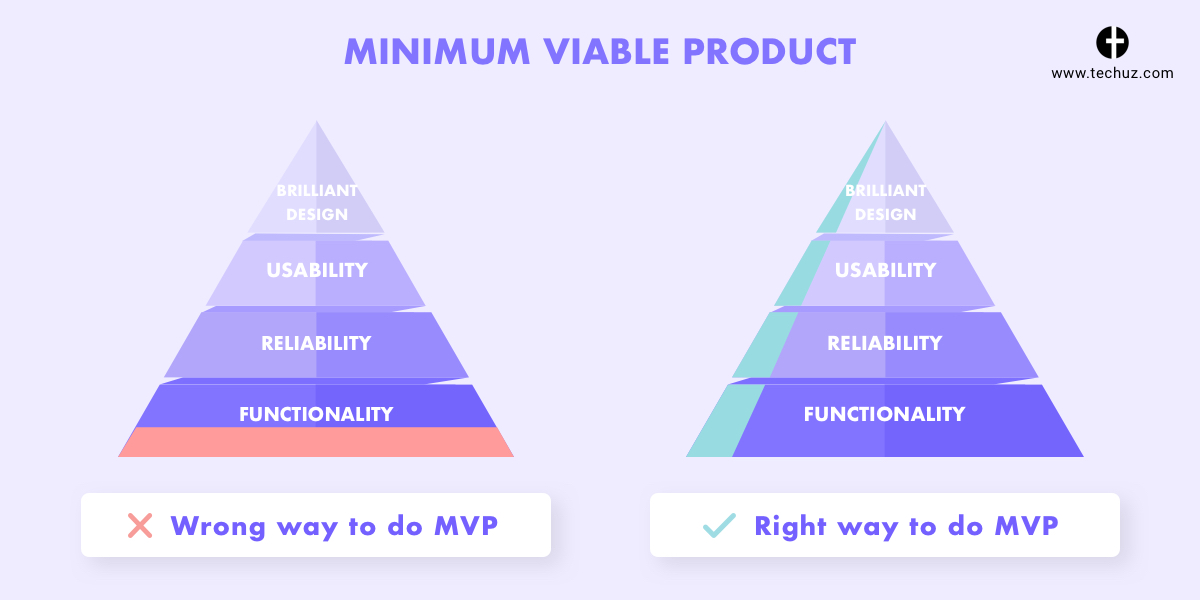
(Minimum doesn’t mean incomplete. Your MVP must provide functionality, reliability, usability and good design)
Selecting the Right Technology
The MVP built with the right technology aligned with the users and business needs can be a deciding factor for the success. While selecting the technology you should consider if the technology is aligned with the functionality of the app, whether it provides scalability and how easy and fast is the development.
Suggested Read: 10 Essential AWS Services to Built A Powerful Cloud Architecture
Functionality
The technology should be aligned with your customers as well as business needs. For example, Angular provides great options for inbuilt libraries while React has a wide range of third-party libraries. So while developing an enterprise-grade application, choosing Angular that has reliable libraries is a good choice.
Scalability
Another important factor is the ease of scalability. Initially, an MVP is aimed to serve a comparatively small group of the audience but as it attains the product-market fit and users grow, you need to scale it. Make sure your technology provides ease of scalability.
Time to Market
The faster the time to market, the earlier you can start receiving feedback — and the faster you can work on the future developments.
Test the MVP Before Launch
Once the MVP is developed, it is essential to perform varied testing before it reaches the users. The MVP is deployed on the staging server where it should go through a combination of alpha and beta testing. Alpha testing is performed by the internal team — such as quality engineers and developers to find out any errors or bugs that affect your MVP and user experience. And as the MVP passes the test, it goes through beta testing where it is tested by real users before the launch.
5. Measure, Learn and Improve
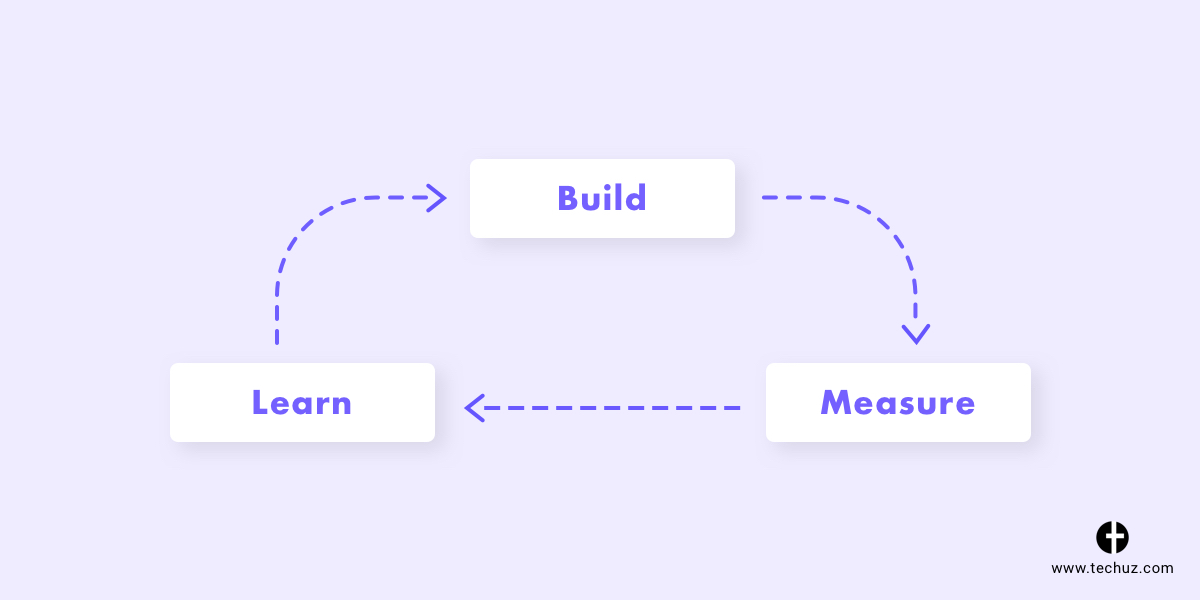
Once you have launched the MVP in the market, it’s time to review the performance of the product. You need to collect and analyze the feedback of the users that’ll help you to determine whether your idea is accepted or rejected by the users, what it lacks, features you need to add or remove and working to building a new version of your application.
Apart from the direct customer feedback, you can employ different metrics to determine how your MVP is performing in the market. Here are a few of the effective metrics.
Traffic
Traffic determines the number of users visiting your platform. Though high traffic means high popularity of the application, you need a combination of other metrics to get a clear picture of the success.
Signup and Registration
Signups measure the interest of the users in your product. A high number of signups means the users are willing to use your product and even pay for it.
Engagement
If signups determine the interest, engagement shows that the users are enjoying your product. Engagement includes metrics such as time spent on the platform, frequent revisits, in-depth interaction with the platform, etc.
Suggested Read: How to Boost Conversion Rate with Web Design?
Active Users
The number of users that not only signed up but also are actively using your platform.
Client acquisition cost (CAC)
Client Acquisition Cost is a good measure to determine the effectiveness of your marketing efforts. CAC refers to the cost to get a paying customer. You can determine it by dividing money spend on the efforts by a number of customers acquired with that effort.
Churn
Churn shows the percentage of users that have abandoned your product such as the number of users uninstalling the application.
Some of the Popular MVP that Made it Huge
Foursquare
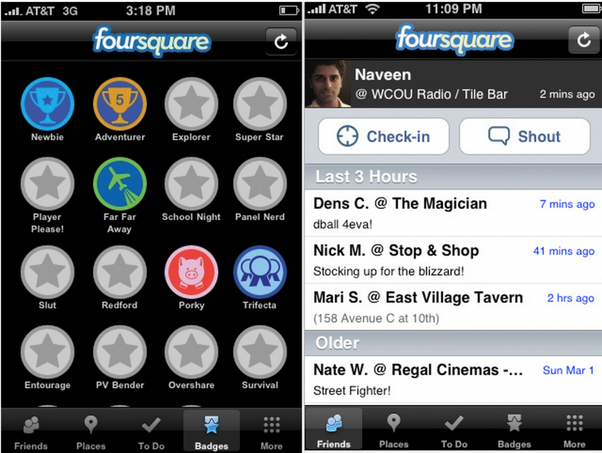
Foursquare is a good example of MVP that started with bare-minimum features. The founders Dennis Crowley and Naveen Selvadurai were familiar with how the business world works. They wanted to first validate their idea before investing in a fully-featured social media platform. So they launched an MVP with just one single feature —allowing the users to check-in on the platform and earn them badges for their activity. Once their idea proved to be successful they added more features and eventually Foursquare became a fully-featured city guide.
Spotify
Even Spotify focused on catering the core feature in the MVP. They developed a desktop application that allowed users to stream music. It was a freemium service and the idea proved to be a huge hit among the users. Eventually, the team added more features, signed more artists and developed mobile applications.
Airbnb
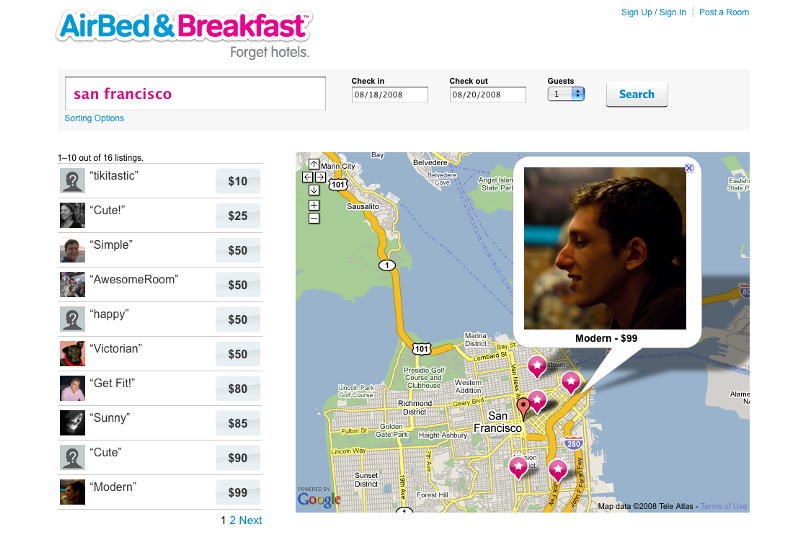
Airbnb, earlier known as AirBedandBreakfast is a one of a kind house-sharing service offering cheap accommodation to travelers. It has over 150 million active users across 191 different countries and has over 5 million listing world wide. But even this behemoth had a humble beginning. Founder Brian Chesky and Joe Gebbia created a web page and posted the pictures of their apartment to test their ideas. Soon they had 3 guests paying for a short stay and over the time their platform gained popularity.
Amazon
Amazon, one of the four most influential technology companies of the century was started as a modest online bookselling platform. Its MVP was a simple website that focused on selling books. The idea of ordering the books with just a few clicks proved successful and gradually it started selling different products online. The rest is history.
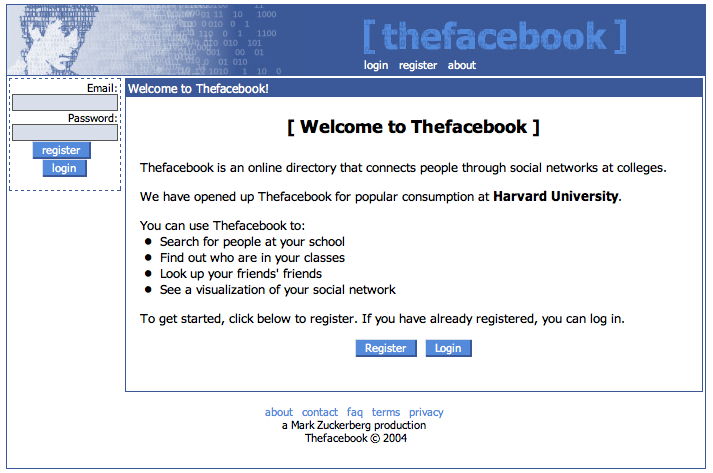
As of the second quarter of 2019, Facebook has almost 2.41 billion active users. But back in 2004, it was an MVP launched as “thefaceBook.com” and was open only for Harward students. At that time it just allowed the students to send messages and post updates. This idea gained momentum and the platform was used by the students countrywide.
Facebook’s MVP was effective, it targeted just one segment of the users — students, provided the minimum necessary features and improved by collecting the feedback over time.
Wrapping Up
To wrap up, let’s recap the steps to build your MVP.
- Conduct thorough market research. Before validating your idea with MVP, validate it through market research.
- Define the User or UX Flow of your MVP.
- Prioritize the features of your MVP to include only the necessary ones.
- Build a functional MVP that solves the problem and meets the users need.
- Measure the success of the MVP, learn from the feedback work on building the future version of the product.
And remember: anything big starts small. Zappos, Facebook, Amazon and Airbnb are the are living proof and even your idea can be the next big thing. The key is to focus on launching an MVP of your idea and improve it with time — instead of focusing on building the entire product.
Even we launched our own mobile app — Digital Private Vaulte applying the same development concept of MVP. It is a vault-app with the philosophy to help users secure their privacy. The initial version included the basic features that allowed users to hide their photos, videos and notes. And gradually we are adding more privacy features as per the market feedback.
Hope you have enjoyed reading this article and gained necessary information on building your MVP. We are Techuz, a mobile app and web development company helping startups to built their idea. If you have any questions or queries on building your MVP feel free to drop us a line here.
